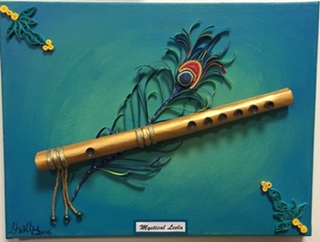Who Am I?[1]
Discerning what is ‘I’ and what is ‘not-I’ (ātmānātma-vicāra)
Perhaps the most important question that Vedānta attempts to tackle is Who am I really? Generally, we take ourselves to be a separate and limited body-mind-senses complex. Vedānta says that this is the basic misconception we have regarding our true identity. Vedānta declares that I am not the limited and changing psychosomatic apparatus I mistake myself to be; I am indeed the limitless and unchanging Consciousness principle. However, I experience myself as a limited entity, limited by time, space and causality. How does Vedānta establish this fact that I am limitless Consciousness which is quite contrary to my direct experience?[2]
Vedānta recommends Self-inquiry (ātma-vicāra) to reconcile this apparent contradiction between what I take myself to be and who I am in reality. This inquiry is conducted in two stages, using two methodologies (prakriyās) as follows:
- Anvaya-vyatireka (co-presence and co-absence)
- Adhyaropa-apavāda (superimposition-negation)
Anvaya-vyatireka (co-presence and absence)
The anvaya-vyatireka analysis is generally used to establish cause-effect relationships between two events or things. Here, we use a special form of anvaya-vyatireka prakriya called anuvarta-vyāvratta (अनुवर्त-व्यावृत्त): to show that one thing has continued existence (anuvarta) while the other thing comes and goes (व्यावृत्त). What is invariably present in all our experience and what is not subject to change is anvaya or anuvarta. What is sometimes present and sometimes absent and what is, therefore, subject to change is vyatireka or vyāvratta.
For example, gold is present when the necklace is present. This is anvaya. When gold is absent, the necklace is also absent. This is vyatireka. So, when the necklace exists, gold also exists. When the necklace is broken, the gold still continues to exist. From this analysis, it is concluded that gold is real while the necklace is non-real (mithyā). In other words, gold is really real while necklace is dependently or apparently real. This analysis can also be applied to the three states of waking, dream, and deep sleep to arrive at the understanding of the Self as the invariable Witness of these states.
During waking state, I experience myself and the physical body. During dream state, the Self experience is there and mind is experienced also, but the body experience is not there. In deep sleep, I continue to experience myself,[3] but the mind and the body is not experienced. Thus, I, the Self, continue to exist in all three states while body and mind and the world do not exist in the deep sleep.
Therefore, body-mind are the incidental, adventitious features that I have which are subject to arrival and departure. What is incidental (and comes and goes) cannot be my true nature. Therefore, from the analysis of three states (avasthā-traya-viveka), I find out that I am different from my body and mind. That I am different from the world, I know. For that, there is no need to conduct any inquiry (vicāra). That I, the Self, subsist as the invariable Conscious principle in and through all states and stages of life requires an inquiry.
Śrī Dakṣiṇāmūrti Stotram, a short devotional text attributable to Śrī Śaṅkarācārya, distills the entire teaching on the subject in a short compass of few lines in its verse 7 as follows:
Self persists in all stages of life like boyhood etc., in all states like waking etc., and all other conditions, — among all these conditions which constantly manifest, the Self continuously illumine them as ‘I am.’[4]
This technique is very important to arrive at our true nature. As the Catuḥślokī Bhāgavatam 2.9.32-35 avers, “He who wants to know the truth of the Self should investigate as to ascertain what it is that exists everywhere and always, for that is the Self.[5] That which is invariably and ubiquitously present in all states and times is the Self, the Ultimate Reality.[6]
Thus through anvaya-vyatireka analysis, I come to know that I, the Self, am different from body, mind, and the world.[7] Body-mind and the world are of the same order and are referred to as non-self, anātmā, in Vedānta. But there is still duality (dvaita) between I, the Self, and body-mind-world, the non-self. There is still no advaita siddhi. Therefore, the second stage of inquiry is conducted.
Adhyaropa-apavāda (superimposition-negation)
This inquiry is conducted to find out the relationship between the Self (ātmā) and the non-self (anātmā). This methodology involves understanding cause (kārṇa) and effect (kārya). First, we provisionally accept (adhyaropa) the reality of effect. Next, we recognize the cause in the effect. Finally, we negate (apavāda) the effect as being dependent and non-different from cause. Cause is regarded as really real (satyasya satyam) while the effect is only dependently real (mithyā).
Let’s take the classic example of clay and pot.
Clay perspective: Clay exists as a cause of all varieties of pot.
Pot perspective: Pot exists, but only as an effect of clay. The existence of pot depends upon clay but clay exists independent of the pot.
So, clay is real while pot is mithyā.
We now extend this logic to Self and non-self.
It is our common experience that any observed object is proved only through the existence of the subject, the observer.[8] If I, the subject, do not exist as the observing consciousness, the world cannot be known to exist as an object. Therefore, through adhyaropa-apavāda analysis, the Self is shown to be the substratum (adhiṣthānam) of the appearing and disappearing of the three states.[9]
While the Self, the subject, can exist without the world. So, I, the Conscious Principle, lend existence to the waking world, just as I, the Self, lend existence to the dream world. I am the cause; the world is the effect. Here, Vedānta makes another beautiful observation: the effect cannot limit the cause. The non-self (body-mind, and the world) cannot limit me, the Self. Therefore, I am free from limitations.
This freedom from limitations is called Brahman. Vedānta points out that we experience this limitlessness daily during our deep sleep (śuṣupti). During my waking state (jagrat avastha), due to my identification with the non-self (the body-mind-complex), I feel limitations. Vedānta says we should own up to our true status of Limitless, unchanging Consciousness (nirdoṣam Brahma) and be free.
——————————————
[1] Based primarily on Swāmī Paramārthānanda jī’s discourses titled “Essence of Vedanta.” [Discourse number one].
[2] There is no law which says that what is experienced is a valid knowledge. For example, blue sky is experienced; it is not a valid knowledge; Sunrise and Sunset is experienced; it is not a fact; and flat Earth is experienced, it is not a fact.
[3] It is everyone’s direct experience that we exist during sleep, otherwise, we will not be able to wake up. Mind completely subsides (otherwise we will still be in the dream state) and there is no body experience at all. Besides, everyone talks about their sleep experience as blissful. That means I, as the Self, is present during deep sleep to experience bliss.
[4] Translated with explanation by Br. Pranipata Chaitanya. Retrieved Oct. 30, 2016: http://advaita-academy.org/shri-dakshinamurti-stotram-part-5/ [Adapted by the author] Br. Pranipata Chaitanya, my revered teacher, who patiently taught me the Bhagavad Gītā with Śaṅkara-Bhāṣya over Skype for a period of three years. His dedication to the tradition of Vedānta was truly inspiring.
बाल्यादिष्वपि जाग्रदादिषु तथा सर्वास्ववस्थास्वपि
व्यावृत्तास्वनुवर्तमानमहमित्यन्तः स्फुरन्तं सदा ॥७॥
bālyādiṣvapi jāgradādiṣu tathā sarvāsvavasthāsvapi
vyāvṛttāsvanuvartamānamahamityantaḥ sphurantaṁ sadā ||7||
[5] N. Raghunathan, trans., Śrīmad Bhāgavatam, vol.1 (Madras, India: Vighneswara Publishing House, 1976/1981), 118. [emphasis added]
[6] एतावदेव जिज्ञास्यं तत्त्वजिज्ञासुनात्मनः ।
अन्वयव्यतिरेकाभ्यां यत्स्यात्सर्वत्र सर्वदा ॥ ०२.०९.०३५ ॥ Catuḥślokī Bhāgavatam
etāvadeva jijñāsyam tattva-jijñāsunātma-naḥ |
anvaya-vyatirekābhyām yat syāt sarvatra sarvadā ||
What the seeker after Truth has to grasp is that Substance which persists always through all its Transformations into its various effects or forms, but suffers no diminution in the process. The Supreme Self is the ultimate Substance. [Translation adapted from Swami Tapasyananda, Srimad Bhagavata – Vol. 1 (Chennai, India, Sri Ramakrishna Math, 1980)]
[7] Anvaya-vyatireka bhyām ātmana-anātma vilakṣanattva nirṇayaḥ.
[8] dṛik adhīna driṣya siddihi.
[9] adhyaropa-apavāda bhayām ātma-anātmana adhiṣthānam nirṇayaḥ.


Recent Comments